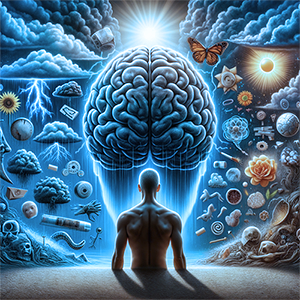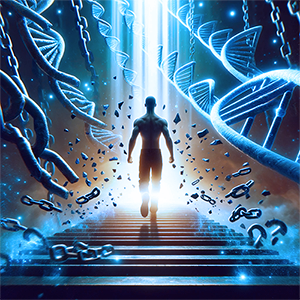Misfortune—a universal chapter in the human story. Each of us, at some point, is touched by the unexpected and painful hand of adversity, whether it’s a stroke of bad luck or a deeper, prolonged tribulation. It’s a common thread that unites us all in the search for sustainable well-being, resilience, and understanding in the face of life’s inevitable downturns. But what if your darkest, most anguishing moments aren’t as random as they appear? Consider, for a moment, that within the tangled web of misfortune lies a pattern, a sequence of cause and effect that you can learn to see and, with that insight, predict and navigate.
To understand the “anatomy”—the mechanics—of bad luck, you must journey into the heart of these very trials. You must uncover a deep understanding that what often feels like the cruel spin of a cosmic wheel beyond our control can, in fact, be consistently and reliably brought under your influence. Instead of resigning yourself to fate, you can instead recognize the power to change the very narrative of your life. By revealing the underpinnings of your misfortunes, great and small, you can find clear pathways out of them. And through simple, gradually intensifying “wins” in the fabric of your own life, you begin to influence more than your own outcomes—eventually, you begin to forge a future for humanity with other individuals of like mind where adversity can not and does not define you.
“The Anatomy of Misfortune” is an exploration of resilience—an invitation to a collective rising above the misfortunes that bind us and a first step towards a future rich with newfound optimism and opportunity. That future is yours if you will only see—and understand.
 The Complex Interplay of Emotions and Bias
The Complex Interplay of Emotions and Bias
In a landmark study conducted by Baumeister and colleagues in 2001, empirical evidence was presented that substantiated the psychological phenomenon known as the “negativity bias.” The study, titled “Bad is Stronger than Good”1, explicates various domains wherein negative experiences exert a more substantial and enduring influence on an individual’s cognitive processes, feelings, and behaviors than positive experiences. This pervasive pattern of negativity bias implies that the human psyche may be more attuned to recognizing and reacting to adverse stimuli than pleasurable—an evolutionary adaptation that once served our hunter-gatherer ancestors to elude threats and survive in hostile environments. But in the contemporary fabric of society, this preponderance of negativity can pose significant hurdles for individuals struggling to move towards a restructured, optimistic mindset.
The Baumeister et al. study demonstrates how negative imprints on our neural architecture—formed through undesirable events and emotions—can potentiate feedback loops that fortify these neural pathways, making them more salient and readily activated. These neural impressions manifest as prejudicial thought patterns, frequently leading to disparaging self-talk or fostering a strong tendency for pessimism. This affinity for negative thoughts poses a particularly formidable problem for anyone trying to cultivate an optimistic outlook, especially with a history of considerable misfortune. The more one experiences setbacks, regardless of reason, the more the mind’s pendulum begins to swing automatically in the direction of darkness and despair. In this neurochemical milieu, saturated with stress hormones such as cortisol, particularly during distressing episodes, the amygdala is galvanized into heightened emotional responses and the solidification of memories of these experiences2. It’s a state where any setback, irrespective of magnitude, can markedly impair one’s mood and perturb social dynamics, effectively “closing the door” to transformative thinking. These adverse events, ranging from trivial disappointments to grievous tragedies, harness a detrimental sway on one’s demeanor and interpersonal relationships, with repercussions that extend beyond the precipitating negative event, undermining both unfavorable and favorable emotions.
In contrast to the binding grasp of calamitous events, positive experiences, though desirable, dissipate fairly quickly from our conscious awareness and exert less of a transformational impact on our established neural pathways. The divergence in the etching of positive and negative experiences within our neural substrates is attributed, in part, to the differential engagement of brain structures and functions during the encoding and retrieval of these memories. The hippocampus and the prefrontal cortex play principal roles in memory and emotion regulation, respectively3. However, findings suggest that negative experiences often commandeer these structures more effectively than positive ones, paving the way for negative memories to be more vividly impressed and easily recalled. Furthermore, the bad-tempered nature of discouraging or demoralizing emotions exacerbates their sway over us, and in the early stages of a conscious attempt to alter one’s mindset, these emotions can pose an uncompromising blockade to personal development.
For an individual invested in reshaping their “mental landscape” to one of optimism, the heightened and extended impact of negative events, as presented in Baumeister’s study, becomes particularly cautionary. Such individuals must generate a great deal of willpower and perseverance to retrain their neural circuitry and bolster resilience against the underlying tendency to favor negative experiences—an undertaking that is as much a relearning process as it is a neurobiological challenge. While techniques rooted in cognitive-behavioral therapy (CBT) and mindfulness strategies have shown some efficacy in rebalancing this cognitive asymmetry, they tend to be broadly ineffective when there are pre-existing hormonal, neurological, or other metabolic disturbances in the body. Ultimately, the central struggle lies in the inextricable imprint of negative experiences that overshadow even concerted efforts to cultivate positivity.
Therefore, the journey toward an optimistic mindset in the wake of powerful and persistent negative biases demands steadfast commitment, encompassing the gradual restructuring of deeply entrenched neural pathways and the continual cultivation of adaptive emotional responses. It can be likened to turning around a large oil tanker in the ocean to move in the opposite direction. The transition is slow, gradual, and consistent, and you need to have an unshakeable commitment going into it that you will persist until the shift has occurred. That commitment can be inspired by the knowledge that just as the pendulum tended in the past to swing towards the negative, it can be gradually coaxed to prefer the opposite. And that, as they say, is the “promised land” where remarkable changes begin to happen outside the realm of what was previously imaginable.
 The Foundations of Helplessness and Resilience
The Foundations of Helplessness and Resilience
Learned helplessness is a psychological condition in which an individual has learned to act or behave helplessly in situations where they have the power to change their unfavorable circumstances. This behavioral paradigm, initially demonstrated in animal studies by psychologists Martin Seligman and Steven F. Maier, illustrates how exposure to uncontrollable and repeated adverse events can condition an organism to believe it is incapable of altering its situation.
The evolution of learned helplessness from childhood into adulthood can be closely tied to neuroplasticity—the brain’s ability to reorganize itself by forming new neural connections throughout life. In childhood, neuroplasticity is at its peak, as evidenced by a wide array of neuroimaging studies, facilitating rapid learning and adaptation. However, as one ages, there is a natural decrease in this plasticity, often resulting from reinforced thought patterns and behaviors that strengthen specific neural pathways while neglecting others, ultimately solidifying the learned helplessness mindset. Research in neuropsychology demonstrates the relationship between chronic stress and plasticity reduction, as articulated by Lupien et al. in their review of the effects of stress on the brain4. This phenomenon also seems to influence the balance of neurotransmitter systems, such as glutamate and GABA, crucial for neuroplasticity.
The learned helplessness paradigm is deeply intertwined with the fear of failure and subsequent procrastination—a behavioral manifestation interpreted as an avoidance tactic driven by the dread of negative evaluation and consequent shame. In a psychological context, procrastination engenders a “perfect storm” for setbacks and misfortune, as it interferes with timely goal-directed behavior, which is vital for personal and professional development. Delving into the neurobiological underpinnings of this dilemma, it has been suggested that procrastination may be associated with poor stress regulation. Research in behavioral neuroscience has posited a link with dysfunction within the prefrontal cortex—responsible for executive function, impeding an individual’s ability to prioritize and execute tasks5. This dysfunctional neural circuitry often coexists with an internal narrative proving counterproductive, a series of sequential thoughts and beliefs anchored in experiences of inferiority and failure. Such beliefs are a byproduct of cognitive processes that have deep roots in neurobiology and reflect a conditioned state of one’s past experiences, which sequentially script the psychological reality of one’s existence, influencing future choices and actions.
The psychological paradigm of learned helplessness potentially cascades into physiological implications, wherein thoughts can manifest as “bodily poses”—patterns of behavior and posture that reciprocatively resonate with our internal narratives and sense of self. This phenomenon touches upon the somatic marker hypothesis presented by Antonio Damasio, which suggests that emotional processes guide (or bias) behavior, particularly decision-making6. One’s mind-body narrative, when entrenched in helplessness, may provoke a state conducive to the deterioration of physical and mental health, especially with regard to the endocrinological and immunological systems. The interchange between thoughts and physiological processes has been subject to extensive scientific scrutiny, observing that neuroendocrine modulators respond to psychological stimuli, as the hypothalamic-pituitary-adrenal (HPA) axis reacts sensitively to stress and mental states, inducing changes in cortisol levels that can influence immune function7. Thus, chronic negative thinking may exacerbate the expression of disease.
In contrast, positive interventions promoting broader meaning and altruism can potentially reverse these effects. Serving others instead of obsessing over oneself can catalyze personal healing, redeploying neuroplastic potential in favorable ways, and encouraging resilience. For decades now, it has been well-established that positive psychological well-being is associated with reduced mortality in the face of cardiovascular disease. With patience and persistence, changing one’s thoughts can eventually steer the body toward equilibrium—signifying a psychosomatic convergence toward health as part of an iterative journey where the pursuit of “big meaning” outside the confines of the individual life facilitates the alignment of body and mind.
Breaking Free:
Conquering Learned Helplessness and Cultivating Resilience
In order to recognize your own personal “anatomy of misfortune,” you must keep a brutally honest inventory of all personal philosophies. This eventually leads to the epiphany that you have subscribed to a deterministic worldview where setbacks and an increased likelihood of unpleasurable events reign supreme. This insight lays bare the psychological underpinnings of degraded self-esteem, its structural integrity compromised by the pervasive infiltration of self-deprecating convictions and actions—akin to the pathology of a pervasive cognitive disorder.
The process of “dismantling a suboptimal neural net” is analogous to the reengineering of maladaptive brain circuits; fundamentally, it is the unraveling and subsequent re-wiring of synaptic connections that foster resilience instead of despair. Attempting to extricate oneself from the throes of negativity warrants an existential struggle, often in direct defiance of a presumably ill-fated destiny. It is a psychological warfare in which perseverance against overwhelming odds—the very act of “showing up”—becomes the antidote to the venom of self and world hatred. True resilience, as opposed to helplessness, is built upon the neural substrates of reward and motivation systems within the brain. Dopaminergic and serotonergic neural pathways, for example, have been implicated in the modulation of mood and agency, suggesting that a shift from passivity to determined action can be cultivated through cognitive-behavioral interventions.
This “pilgrimage” towards strong-mindedness absolutely mandates a complete severance from pernicious influences—negative individuals, biased media streams, and toxic work environments. Such isolation is an intermediary developmental stage, for it paves the way to a new existence characterized by compassion, transformation, and—at its highest expression—global change. In the back-stabbing grips of learned helplessness, any adverse event serves as a confirmation of debilitating beliefs, further shattering an already fragile self-esteem. This corrosive dynamic embodies a self-fulfilling prophecy, wherein the conviction in your unworthiness of success or happiness imprisons you within a vicious cycle of self-sabotage and intermittent reinforcement of failure.
 Misconceptions about the Pursuit of Happiness
Misconceptions about the Pursuit of Happiness
Science has been interested for quite some time in the difference between self-generated positive outcomes—due to a consistently optimistic mindset—and random triggers for elation, such as lottery winnings and other financial windfalls. Research by Brickman et al. in 1978 provided a seminal perspective on this dichotomy. They conducted a study comparing lottery winners to non-winners and individuals who had experienced traumatic accidents8. This study illuminated the counterintuitive phenomenon that lottery winners did not report a sustained increase in happiness and, notably, derived less pleasure from day-to-day activities than the control group. This conundrum can be unpacked through the lens of hedonic adaptation—a psychological phenomenon wherein individuals return to a stable level of happiness despite major positive or negative life changes. Thus, a sustainable state of happiness and well-being derived purely from the acquisition of wealth is truly impossible. It fails to yield lasting fulfillment due to the recalibration of one’s emotional baseline, diluting the potency of new experiences.
Investigating further, the pernicious cycle of chasing wealth as an end ensnares individuals in a relentless pursuit of external validation while neglecting the intrinsic development of the automaticity of “chronic optimism.” The neurobiological implications for this notion are profound. Repeated hyper-stimulation, whether via substance use, sex, risk-seeking behaviors, or the dopamine surges associated with intermittent financial windfalls, can lead to alterations in brain neuroplasticity. Such recurrent overstimulation can provoke neurotransmitter receptor downregulation or pruning9 and set the stage for anhedonia—a chronic inability to feel any pleasure at all. Consequently, the brain’s reward circuitry recalibrates, demanding higher levels of stimuli to evoke a comparable positive response. Therefore, in order to avoid such undesirable outcomes, one must embrace a paradigm shift towards fostering a stable, reliable “baseline” hedonic tone that avoids both negative and positive extremes. This middle ground nurtures a biochemical milieu conducive to well-being in the absence of extreme stimulations.
Without such careful balance—the foundation for continuous, unbroken well-being cannot be established; it is forever fractured by momentary exhilaration. When you are in a state of “chasing pleasure,” you are extremely vulnerable to the beguile of heightened euphoria in the wake of sudden changes of fortune, leading to stark mental contrast with everything that came before it. To sidestep such vulnerability, you must grow into what I call “pathological optimism”—a state that consistently expects positive outcomes without experiencing the desperate need for stimulation.
This mindset gradually dawns on you, increasing in depth and intensity over time to the point of overshadowing even the most extreme dopamine highs. It is the difference between a large radiant sun and a short but devastating fire. Your pleasure-reward system cannot sustain constant engagement without retreating—for a number of reasons, not the least of which is protection against the highly oxidative nature of excess dopamine—and the potential for neurodegeneration.
 How Meaning Overcomes Adversity
How Meaning Overcomes Adversity
The pursuit of meaning is a quintessential aspect of human existence, without which many of us would be devoid of motivation. Meaning can be realized at multiple levels of existence, beginning at the individual and expanding outward to eventually encompass familial and societal realms. At the nucleus of this hierarchy, the individual seeks to find meaning in personal accomplishments, sensory pleasures, and emotional gratification. Neuroscience research suggests that the engagement of reward circuitry, including the ventral tegmental area and the nucleus accumbens, is highly active when individuals experience pleasure or success10. However, this form of meaning is susceptible to being ephemeral, exemplified by the hedonic treadmill phenomenon, wherein individuals quickly return to a baseline level of happiness despite significant positive or negative events11. Personal misfortunes—physical illness, financial loss, or emotional traumas—can readily undermine the individual-centric purpose, for its stability is inextricably linked to fluctuating personal circumstances.
Expanding beyond the self-centric sphere, an individual’s meaning derived from family — kinship ties, offspring, and spousal relationships — provides a more stable foundation bolstered by the evolutionary underpinnings of genetic perpetuation and social support structures. As such, family-level meaning benefits from a potent combination of biological drives and socio-cultural reinforcements. The biologically rooted mechanism of inclusive fitness, as described by William D. Hamilton, implies a genetic predisposition to acts that ensure the survival of family members12. Additionally, psychological research has identified the positive impacts of social bonds on mental health, with supportive relationships acting as a buffer against stress13. Notwithstanding these protective layers, family-oriented meaning can still be disrupted by misfortune, albeit to a lesser degree than individualistic pursuits. Familial adversities, such as bereavement or chronic illness affecting a family member, can compromise the meaning derived from this mid-level collective.
Pivoting from the familial to the societal domain, the scope of meaning broadens, encompassing civic engagement, professional achievements, and contributions to human knowledge or culture. This stratum is characterized by the pursuit of legacy, societal recognition, and the quest for enduring impact, all of which are less directly influenced by individual misfortunes. The psychological concept of generativity — the concern for establishing and guiding the next generation, as discussed by Erik Erikson in his stages of psychosocial development — exemplifies a societal-rooted form of meaning that transcends the individual and has the capacity to withstand personal loss.
Societal meaning is often associated with the utilization and reinforcement of cultural capital14, which can persist even in the face of individual setbacks due to its transpersonal nature and dissemination among numerous individuals. For example, scientific contributions, once made, become part of the collective knowledge pool, symbolized by the collaborative web of citations and continued research, exhibiting resilience despite the potential misfortune befalling the originator. Thus, as the level of meaning ascends from the individual to the societal, there is an observable gradient of increasing stability against misfortune, with broader influence affording greater protections by distributing meaning across a wider spectrum of individuals and institutions.
Ultimately, the proper antidote to the random blows of misfortune lies in pursuing meaning beyond oneself. When we orient our lives towards service to others and the greater world, we build a life that is not just less vulnerable to individual setbacks but also enriched with a profound sense of purpose. As we cultivate ties that bind us to family, community, and societal progress, our personal tribulations are mitigated by the collective strength and continuity of our contributions. This other-centric approach to life’s meaning offers a more stable and fulfilling existence, where the legacies we leave and the support we garner form a resilient fabric against life’s uncertainties, guiding us towards a future where individual adversities are transcended by the enduring impact of our collective efforts.
 Psychological Mechanisms of Coping and Adapting
Psychological Mechanisms of Coping and Adapting
The further you delve into the nature of misfortune, the clearer it becomes that your capacity for happiness and emotional richness is often shaped by the stark contrast between adversity and “good luck.” It is through overcoming life’s hurdles that one’s character is tested and strengthened, giving rise to a profound appreciation for the peaks of joy and success. This juxtaposition not only heightens your gratitude for moments of bliss but also equips you with the empathy to connect with others in their times of need. Ultimately, it is this tapestry of experiences that weaves the fabric of a life filled with meaning, teaching us that the value of our journey is not diminished by the challenges we face but is instead enhanced by the resilience we build and the depth we discover within ourselves.
The Neurobiological Foundations of Resilience and Happiness
The human emotional spectrum is calibrated through a tapestry of life experiences where happiness is often most poignant against the backdrop of prior suffering. The contrast theory of emotional experience suggests that adversities provide a reference point for appreciating good fortune and deepen one’s capacity for experiencing joy15. The neurobiology of this phenomenon lies in the brain’s response to stress and reward. The amygdala and the prefrontal cortex are key players in processing emotions16. Adverse events trigger the amygdala, initiating a stress response that alters neural pathways, enhancing sensitivity to potentially pleasurable stimuli detected by the brain’s reward system, including the nucleus accumbens and the ventral tegmental area17. Dopamine, a neurotransmitter integral to the reward system, mediates pleasure sensations, and its release can be more pronounced following a period of deprivation or stress18. Thus, those who have encountered hardships may experience amplified responses to positive events, contributing to a richer emotional landscape.
Social psychology posits the concept of “strength in numbers,” particularly in relation to collective expectations of fortune or misfortune. Through shared experiences and emotional contagion, a group’s collective memory can reinforce individual memories, intensifying the emotional “charge” of expectations19. This principle is akin to the propagation of waves in physical sciences, where the amplitude of a wave can be magnified by constructive interference. Translated to societal context, the convergence of similar experiences and attitudes can lead to a swell of collective sentiment, amplifying individual predispositions towards optimism or pessimism. Furthermore, chronic exposure to groupthink and shared narratives can solidify these expectations within the psyche, creating cognitive biases that shape perception and memory recall20. As a result, individuals enmeshed in such a milieu may find themselves trapped in a cyclic expectation that unduly influences their reaction to life’s transitions. At the societal level, this manifests as unrest, socioeconomic tension, and even war.
In contrast to being swept up in the waves of collective expectation, there exists the capacity for humans to step outside the normative bounds of social consciousness. This difficult, often uncomfortably divergent act can result in the formation of fresh perspectives that challenge the status quo. Such psychological independence is predicated on self-awareness and cognitive flexibility, traits supported by neural connectivity’s dynamic nature 21. This flexibility allows for the pruning and strengthening of synaptic connections in the brain, a process influenced by repeated experiences and thought patterns. Neuroplasticity, the brain’s ability to reorganize itself, is at the core of this capability. When you consciously choose to escape the prevailing doom and gloom, you are effectively rewiring your neural pathways to favor interpretations and emotional responses resilient to mass expectations22. Finding like-minded individuals can create a counter-current, a new wave of perception and expectation that eschews the propensity for negative forecasting and opens the space for alternative, optimistic narratives to thrive.
Memory, perception, and expectations are not immutable entities but are, instead, constructions that the mind is continually shaping. Mood-congruent memory recall, confirmation biases, and emotionally charged retrieval can significantly distort how past events are remembered and future events are anticipated23. These distortions are subject to many influences, including current environmental stimuli, underlying psychological conditions, cultural context, and social interactions. The brain’s remarkable capacity for neuroplasticity again becomes central, as it allows for the “relearning of the past”—the reinterpretation of previous experiences in light of new information or insights24. This relearning capacity has profound implications for preempting misfortune by building mental resilience. The hippocampus, a region fundamental to learning and memory, interacts with the prefrontal cortex to modulate how memories are consolidated and retrieved in light of present circumstances and future projections. By reframing memories through the lens of growth and learning, you can alter your expectations and responses to potential setbacks, aligning with a neurobiological basis for optimism and adaptive coping25.
In this way, awareness of the scientific principles that underscore emotional depth, perception, and collective expectation provides invaluable insight into the cultivation of personal well-being and the role of individual agency in fostering resilience amidst an often turbulent world. This awareness paves the way for intentional self-growth and the pursuit of a meaningful life, informed by the neurobiology of contrast, memory, and the ever-evolving human experience.
Dynamic Coping Strategies and “Quantum” Behavior
The interplay between the human psyche’s resilience and coping mechanisms is a subject of intricate complexity, magnified under the lens of various scientific domains. Conscious efforts to diverge from a negatively conditioned mental state can significantly enhance one’s ability to employ dynamic and adaptive coping strategies. Resilience is not a static trait but a dynamic capacity that evolves through experiential learning and neuroplasticity. It is characterized by the remarkable adaptability of resilient individuals, demonstrating flexible self-regulation by tailoring their coping techniques to match situational demands. Such flexibility has been supported by empirical research; for instance, Bonanno identified various coping strategies, including potential re-appraisal, positive emotion, and focused problem-solving, which resilient individuals rotate and refine based on contextual necessities26.
These adaptive responses are emblematic of a complex system’s behavior, a notion mirrored in contemporary understandings of quantum mechanics. Just as quantum entities demonstrate probabilistic existence instead of deterministic outcomes, the rich, “polysynthetic” fabric of resilient behaviors in humans evades static predictability, transitioning continuously along a spectrum of possibilities. In light of this quantum behavioral resemblance, we could say that the leap from chronic adversity to consistent fortune involves a transition in mental “states” analogous to quantum state changes.
Theories akin to quantum cognition models suggest that human decision-making processes and coping tactics exhibit similar superpositional qualities until an observation or measurement, equating to a real-life challenge, collapses the possibilities into a lived experience27. Thus, resilience enhancement may be conceptualized as a cognitive “quantum leap” from potentiality to actuality, conditioned by an array of factors within the domains of genetics, neurobiology, and psychology. For example, genetic predispositions28 interact with environmental stimuli to modulate neurotransmitter systems that support cognitive-emotional responses, further mediated by individual psychological frameworks nurtured throughout one’s life. Each variable, from alleles to synaptic connections, contributes to the holistic function of adaptive coping—making the precise prediction of resilience a multifaceted challenge yet to be fully addressed in the scientific community.
Transcendent Decision-Making in an Uncertain World
In the incessant pursuit of personal life, pleasure, and material wealth, decisions are often built upon the precarious foundation of shifting sand, vulnerable to the ups and downs of fate and the unpredictability of circumstance. This instability arises from a decision-making process that is predominantly reactive, governed by the emotional tumult of the subconscious, itself a repository of past experiences and uncertainties about the future. Psychological studies, drawing upon cognitive-affective theories, have established that decision-making under such influence tends to be shortsighted, focusing on immediate gratification rather than enduring outcomes29. A rational, visionary “choice-maker,” conversely, is driven by a profound empathetic resolve to not only improve their individual circumstances but also to make a significant impact on the world. This transition from self-centered decision-making to a transcendent and altruistic paradigm necessitates an evolutionary leap—one that accounts for the holistic integration of personal growth and the collective advancement of society. Furthermore, decision-making derived from a compassionate global perspective is often more resilient during setbacks, possessing a greater capacity for reflection rather than impulsive reactivity30.
In cognitive science, decision-making is widely understood through models of automatic versus reflective processing, epitomized by the well-known “marshmallow experiment” by Walter Mischel. Children’s choices to delay gratification in this experiment hinted at the profound implications for self-control and future success31. The automatic system, fast and emotion-driven, often leads to choices that prioritize immediate pleasure and avoid minor discomforts. In contrast, the reflective system employs higher-order cognitive processes, allowing for the delay of gratification and the formulation of decisions that are resilient and future-oriented. Engaging in delayed gratification can rewire neural pathways, reinforcing behaviors that are less reactive to setbacks and more proactive toward transpersonal objectives. Fundamentally, this involves the dorsolateral prefrontal cortex, which plays a critical role in impulse control and goal-directed behavior, activating neural circuits that underpin patience and strategic planning32.
Past experiences, especially those negative and emotionally charged, significantly influence present decision-making through what psychologists call “mental heuristics.” This fast-track cognitive shortcut can result in an availability bias, whereby individuals overestimate the probabilities of events similar to their past experiences. If an individual has encountered misfortune that is particularly vivid or traumatic, such occurrences disproportionately inform their perception of risk and subsequent choices. These heuristic biases can be distinctly maladaptive, especially when amplified by the mass media, which often sensationalizes rare but dramatic events, thereby skewing public perception. Society thereby becomes a canvas upon which collective fears and biases are drawn, influencing the decisional behavior of its constituents – an effect known as “social amplification of risk”33. This cognitive tendency becomes a key agent in sculpting a future that unwittingly conforms to our worst expectations if not properly mitigated by rational thought and empirical evidence.
The labyrinthine complexity of decision-making is woven from the diverse threads of past misfortunes, familial interactions, cultural contexts, and entrenched thought habits. These various strata profoundly shape the neurobiology of our cognitive processes. Repetitive thought patterns solidify neural pathways, a phenomenon supported by neuroplasticity research, which shows that sustained mental activity can modify brain function and structure 34. For instance, when individuals ruminate obsessively over past adversities or harbor anxieties about the future, they inadvertently hardwire their brains toward reactivity and perceived helplessness, thus fostering a mindset prone to resignation rather than resilience35. This cycle of negative reinforcement can become, in essence, “programmed” into the automatic neurological responses, leading to a diminished capacity for adaptive decision-making and a predisposition to view new challenges through a lens of fearfulness and defeatism.
There is a well-known precept from ancient spiritual traditions that states, “You become what you meditate on”. This resonates with modern neurobiological perspectives—that focused contemplation on specific thoughts, particularly those steeped in emotional intensity, will reinforce them within the subconscious mind, thereby covertly shaping behavior and, concomitantly, decision-making. My own understanding of this principle extends even to the physical manifestation of both internal and external events (through causation), but I will leave that consideration for another time. For now, suffice it to say that compelling neuroimaging studies have documented the influence of emotional memories on decision processes, showing the activation of brain structures such as the amygdala, which is central to the emotional processing of memories, during decision-making that involves emotionally salient outcomes36. This internalization of expectations, primarily those inclined toward negativity and setbacks, propagates a self-fulfilling prophecy, subtly influencing choices in a manner that unwittingly brings those very outcomes to fruition. Thus, the shadow cast by foreboding anticipations can grow to envelop an individual’s entire decisional landscape, unwittingly constraining potential futures to echo familiar misfortunes of the past.
 The Power of Positive Mindsets and the Creation of Luck
The Power of Positive Mindsets and the Creation of Luck
There is an intriguing connection between the abstract concept of luck and the concrete reality of one’s mindset. The causal chain linking luck with a positive outlook is supported by psychological principles, which dictate that beliefs often manifest into behaviors, leading to self-fulfilling prophecies as per the Pygmalion effect37. Those harboring an affirmative frame of mind may engage in behaviors that foster positive experiences; this phenomenon, colloquially known as “like attracts like,” is underpinned by the confirmation bias where one’s expectations lead to behaviors that cause them to come true38. This predisposition encourages individuals to unconsciously seek out affirming social circles and circumstances, thereby shaping their reality.
The transformative power of positivity on one’s life strategy is inextricably linked to neurobiology. Adopting an optimistic outlook has been associated with increased activity in the prefrontal cortex, the brain region involved in goal-setting and motivation39. This cerebral shift can precipitate the restructuring of personal life as one begins to actively and heuristically navigate toward “enlightening” encounters. Under the influence of a positive mindset, an individual’s neuroplastic potential is catalyzed, a concept embraced by Dweck’s growth mindset theory40, indicating that the belief in the ability to improve can indeed engender cognitive transformation.
Consequently, the network effect takes place when “fortunate” individuals form connections with equally driven peers. The dynamics of such networks pave the way for a rich tapestry of opportunities as one builds upon the capital of social connections. Research in social psychology underscores the impact of strong networks on personal and professional development41. These encounters amplify the natural human propensity for social interaction, fostering a diverse array of experiences and, in extreme cases, the unexpected emergence of extraordinary events one might deem “miracles.”
Delving deeper into the subjective canvas of intuition, one finds that a positive mindset inspires a shift in internal dialogues, where subconscious undercurrents characterized by maladaptive schemas can be remolded into affirmative scripts. The freedom from negative subconscious influences primes the decision-making process, sharpening intuition. In fact, optimism is correlated with enhanced decision-making skills because it encourages a broader consideration of possibilities42. Subsequently, individuals perceive setbacks as isolated incidents instead of systemic failures, thus cultivating a resilience that cushions the impact of misfortune. This resilience, manifesting neurobiologically as increased synaptic plasticity in response to adversity43, ensures that even in the face of setbacks, the “chronically fortunate” are predisposed to extract lessons and continue onward rather than dwell on failure. As I mentioned earlier, with patience and perseverance, this can become an automaticity rather than a struggle.
To illustrate the distinction between good and bad luck, a deeper understanding of the fundamental factors that propel an individual toward either end is required. Luck, or perceived serendipity, can often be attributed to the convergence of opportunity and preparedness, a state dwelling within the locus of control—an individual’s belief in their ability to influence events44. Those deemed fortunate actively cultivate their internal and external environments to increase the probability of beneficial encounters. They do this by consistently aligning actions with aspirations, a form of operant conditioning45, and solidifying neural pathways that lead to increased efficiency in goal attainment.
Rooted in optimism and further permeated by positive expectancy, such individuals persist unwaveringly toward their visions. Their cognitive schemas are marked by a persistent belief in eventual success, a form of learned optimism46, which not only reinforces perseverance but often attracts like-minded cohorts. This perpetual cycle of optimistic expectancy and the aggregation of social capital gives birth to opportunities that continually facilitate favorable results, sustaining the perceived experience of continual good fortune. As such, the mechanics of their existence interweave these psychological principles to construct a reality where the so-called “luck factor” is not merely a whim of chance but a cultivated phenomenon.
 Strengthening the Mind Against Chronic Misfortune
Strengthening the Mind Against Chronic Misfortune
So it should be clear at this point that great fortune is, in fact, the conscious, deliberate cultivation of a mindset that has broad influences over body, mind, and collective experience. Individuals mired in an “unfortunate” mindset tend to interpret adversity as retribution—whether divinely ordained or as a consequence of the cold indifference of a universe devoid of intelligent design. This paradigm instigates a detrimental feedback loop, wherein negative outcomes fuel the belief system that anticipates them, which is then substantiated by each new hardship, thus entrenching helplessness and inaction. Studies in the realm of neurobiology have shown that this defeatist outlook can precipitate or exacerbate depressive symptoms and anhedonia—a diminished capacity to experience pleasure—a condition closely monitored using functional MRI to observe brain regions implicated in reward processing, such as the prefrontal cortex and basal ganglia47.These findings render a stark, unforgiving picture: regardless of belief in the metaphysical or the material, subscribing to the narrative that you are “worthy of punishment” creates a psychological milieu ripe for despair.
Conversely, individuals perceived as “lucky” are often former survivors of extreme challenges—individuals who have carved reservoirs of resilience and intentional living from the bedrock of suffering. Nonetheless, we often find ourselves building narratives around these people, perhaps as a defense mechanism, to explain their good fortune— they “have what we want,” so they must have gotten it through either sheer luck, supportive circumstances, or perhaps even advantageous genetic predispositions in the dopamine D4 receptor, associated with novelty-seeking behaviors48. Rarely do we look upon the fortunate as people who have embodied wholeness and understanding. In reality, many such “lucky” people have not merely danced with darkness; they have learned its rhythms and choreographed hope in its vast silences.
You see, fortunate, “lucky” people’s alignment with joy is not accidental but a deliberate sculpting of consciousness through intention, mindfulness, and often—extreme patience and perseverance. Today, it is quite common knowledge what profound effects mindfulness has on the brain’s plasticity, with heightened activity in regions associated with attention, emotion regulation, and self-awareness49. Mindfulness has become the second archetype of personhood—the master of body and mind, the architect of internal experience—representing the pinnacle of human tenacity. For those who have risen above the ebb and flow of their thoughts, good and bad, there is a rich tapestry of vision and perspective that is not predicated on externals. Their cultivated happiness is a sovereign state, completely impervious to material loss or changing circumstances.
These are the individuals that beckon emulation, the life “warriors” that become visionaries and sculptors of humanity’s future. It is not so much that you should emulate their fortunate outcomes, but rather—adopt their principles of psychological “backbone”, compassionate mindfulness, and proactive creation of meaning, knowing that light, when internalized, cannot be extinguished by external forces. This enlightened approach to existence finds its most potent expression in the notion that happiness precedes experience and, once rooted within, becomes an unassailable sanctuary against the assaults of misfortune.
 Step into Fortune and Change the World
Step into Fortune and Change the World
If you feel ensnared in the relentless grip of misfortune, constantly facing life’s adversities, it’s time to embark on a transformative journey. We invite you to schedule a consultation, where we view each individual not just as a client but as a burgeoning visionary capable of transcending all current limitations.
Our program offers a multi-tiered approach to mastery over misfortune. Delving deep into your genetic blueprint with data from services like 23andMe, Gene by Gene, or Ancestry DNA, we don’t just analyze but synthesize a comprehensive understanding of your unique psycho-physical makeup. This program is not merely about overcoming adversity; it’s about rising to a higher plane of existence, where body-mind mastery paves the way for visionary leadership.
Our holistic protocols, tailored to your genetics, lifestyle, and history, are designed to address and rectify imbalances and unlock and enhance your inherent potential. This journey is about redefining the very fabric of your being, transforming vulnerabilities into strengths and trials into triumphs.
In conclusion, transcending misfortune is more than merely navigating life’s challenges; it’s about reengineering your essence to emerge as a visionary leader capable of inspiring change and influencing the world. Through this comprehensive and transformative approach, you can rise above the ordinary, embracing a future where you don’t just survive adversity but thrive as a beacon of resilience, innovation, and visionary thought.
Your brain and past experiences cannot tell you, one way or another, if that can happen. You must make the decision to step into a new life and, ultimately, a new world.
Join our program today!
Transcend Genomics offers an unparalleled opportunity for self-exploration, growth, and radical body-mind optimization. The journey begins with an analysis of over 20,000 genes and 200 metabolic pathways to discover the areas of your genome that could have the greatest impact on your health, cognition, and longevity.

